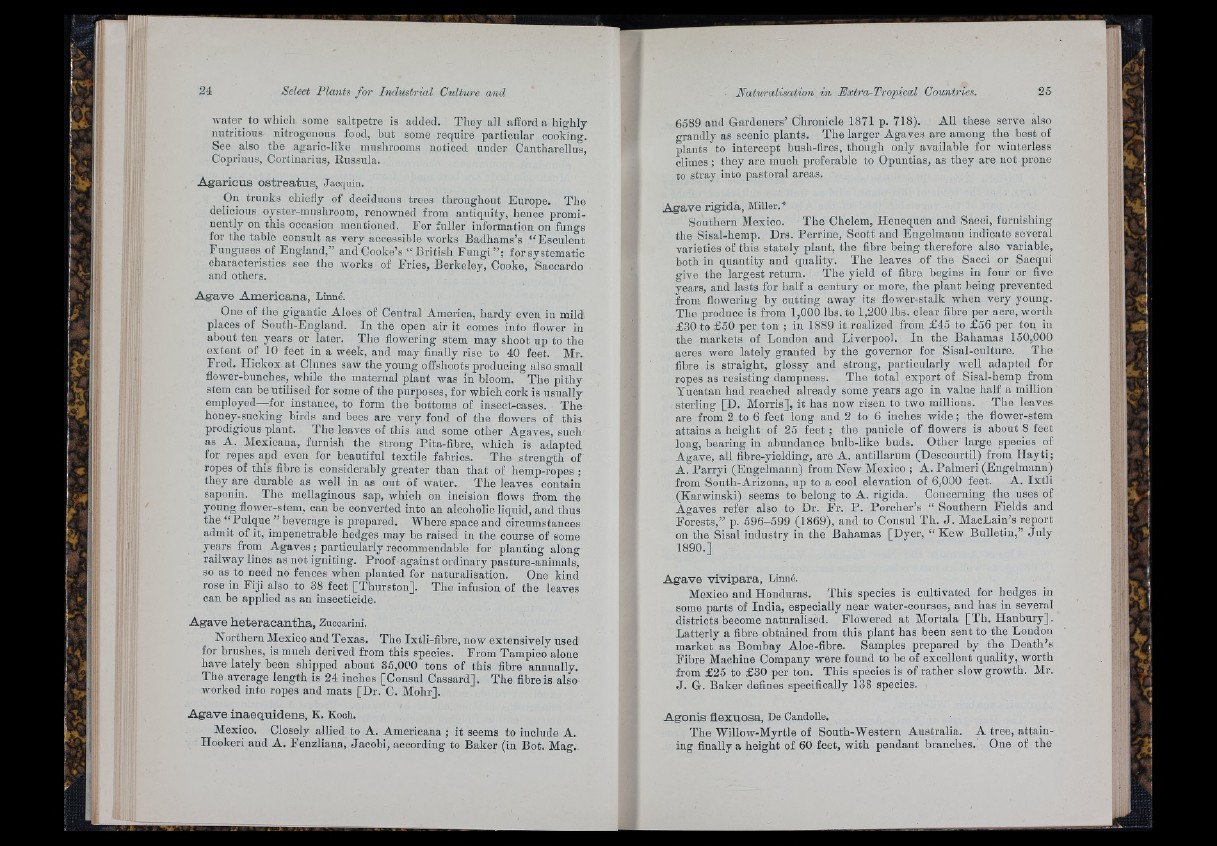
water to ivlaich some saltpetre is added. They all afford a highly
nutritious nitrogenous food, but some require particular cooking.
See also the agaric-like mushrooms noticed under Cantharellus,
Copriuus, Cortinarins, Russnla.
A g a r ic u s o s tr e a tu s , Jacqidn.
On trunks chiefly of deciduous trees throughout Europe. The
delicious oyster-mushroom, renowned from antiquity, hence prominently
on this occasion mentioned. For fuller information on fungs
for the table consult as very accessible works Badhams’s “ Esculent
Funguses of England,” and Cooke’s “ British Fungi for systematic
characteristics see tlie works of Fries, Berkeley, Cooke, Saceardo
and others.
A g a v e A m e ric a n a , Linné.
One of the gigantic Aloes of Central America, hardy even in mild
places of Sonth-England. In the open air it comes into flower in
about ten years or later. The flowering stem may shoot up to the
extent of 10 feet in a week, and may finally rise to 40 feet. Mr.
Fred. Hickox a t Chines saw the young offshoots producing also small
flower-hunches, while the maternal plant was in bloom. The pithy
stem can be utilised for some of the purposes, for which cork is usually
employed—for instance, to form the bottoms of insect-oases. The
boney-sucking birds and bees are very fond of the flowers of this
prodigious plant. The leaves of this and some other Agaves, such
as A. Mexicana, furnish the strong Pita-fibre, which is adapted
for ropes and even for beautiful textile fabrics. The strength of
ropes of this fibre is considerably greater than that of hemp-ropes ;
they are durable as well in as out of water. The leaves contain
saponin. The mellagiuous sap, which on incision flows from the
young flower-stem, can be converted into an alcoholic liquid, and thus
the ‘‘Pulque ” beverage is prepared. Where space and circumstances
admit of it, impenetrable hedges may be raised in the course of some
years from Agaves ; particularly reeommendable for planting along
railway lines as not igniting. Proof against ordinary pasture-animals,
so as to need no fences when planted for naturalisation. One kind
rose in F iji also to 38 feet [Thurston]. The infusion of the leaves
can be applied as an insecticide.
A g av e h e to r a c a n th a , Zuoearini.
B ortheru Mexico and Texas. The Ixtli-fibre, now extensively used
for brushes, is much derived from this species. From Tampico alone
have lately been shipped about 35,000 tons of this fibre annually.
The average length is 24 inches [Consul Cassard]. The fibre is also
worked into ropes and mats [Dr. C. Mohr].
A g a v e in a e q u id e n s , K. Koch.
Mexico. Closely allied to A. Americana ; it seems to include A.
Hookeri aud A. Fenzliana, Jacobi, according to Baker (in Bot. Mag.
6589 and Gardeners’ Chronicle 1871 p. 718). All these serve also
grandly as scenic plants. The larger Agaves are among the best of
plants to intercept bush-fires, though only available for winterless
climes ; they are much preferable to Opuntias, as they are not prone
to stray into pastoral areas.
A g av e rig id a , Miller.*
Southern Mexico. The Chelem, Heuequen and Sacci, furnishing
the Sisal-hemp. Drs. Perrine, Scott aud Engelmann indicate several
varieties of this stately plant, the fibre being therefore also variable,
both in quantity and quality. The leaves of the Sacci or Saoqui
give the largest return. The yield of fibre, begins in four or five
years, and lasts for half a century or more, the plant being prevented
from flowering by cutting away its flower-stalk when very young.
The produce is from 1,000 lbs. to 1,200 lbs. clear fibre per acre, worth
£30 to £50 per ton ; in 1889 it realized from £45 to £56 per ton in
the markets of London and Liverpool. In the Bahamas 150,000
acres were lately granted by the governor for Sisal-culture. The
fibre is straight, glossy and strong, particularly well adapted for
ropes as resisting dampness. The total export of Sisal-hemp from
Yucatan had reached already some years ago in value half a million
sterling [D. Morris], it has now risen to two millions. The leaves
are from 2 to 6 feet long and 2 to 6 inches wide ; the flower-stem
attains a height of 25 feet ; the panicle of flowers is about 8 feet
long, bearing in abundance bulb-like buds. Cther large species of
Agave, all fibre-yielding, are A. antillarnm (Descoiirtil) from H ay tij
A. Parryi (Engelmann) from New Mexico ; A. Palmeri (Engelmann)
from South-Arizona, up to a cool elevation of 6,000 feet. A. Ix tli
(Karwinski) seems to belong to A. rigida. Concerning the uses of
Agaves refer also to Dr. Fr. P . Poroher’s “ Southern Fields and
Forests,” p. 596-599 (1869), and to Consul Th. J . MaoLain’s report
on the Sisal industry in the Bahamas [Dyer, “ Kew Bulletin,” July
1890.]
A g a v e v iv ip a r a , Linné.
Mexico and Honduras. This species is cultivated for hedges in
some parts of India, especially near water-eourses, and has in several
districts become naturalised. Flowered a t Mortala [T h . Hanbury].
Latterly a fibre obtained from this plant has been sent to the London
market as Bombay Aloe-fibre. Samples prepared by the Death’s
Fibre Machine Company were found to be of excellent quality, worth
from £25 to £30 per ton. This species is of rather slow growth. Mr.
J . G. Baker defines specifically 138 species.
A g o n is ü e x u o s a , De Candolle.
The Willow-Myrtle of South-Western Australia. A tree, attaining
finally a height of 60 feet, with pendant branches. One of th e